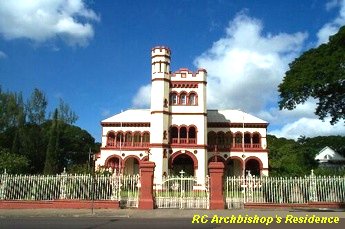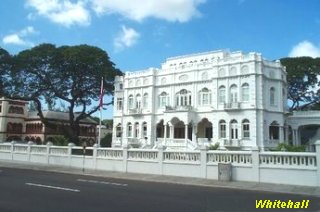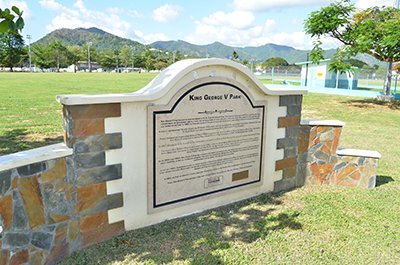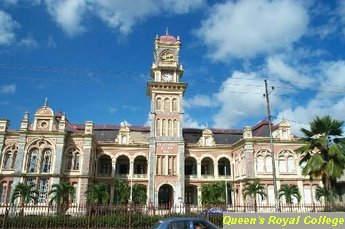|
| Newtown | St. Clair | St. James | Woodbrook |
|---|
 Known for its palatial homes on large plots of land with backyard swimming pools and tennis courts, St. Clair has always been a very elite, quiet, residential community. Bounded by Maraval Road on the East, Tragarete Road on the South, the Maraval River on the West, and Long Circular Road on the North, this community is dotted with parks: the Queen's Park Oval; King George V Park; Jackson Square; the triangular park at the intersection of Herbert Street and Tragarete Road; and the almost trapezoidal expanse of trees on Prada Street. St Clair's history is reflected in its breathtaking architecture displayed by the following seven structures that face the Queen's Park Savannah and line Maraval Road from North to South, respectively: Stollmeyer's Castle; Whitehall; the Roman Catholic Archbishop's Residence; Rumor; Mille Fleurs; Hayes Court; and Queen's Royal College. These seven structures were later named "The Magnificent Seven" after the 1960s American movie of the same name which starred Yul Brynner. Known for its palatial homes on large plots of land with backyard swimming pools and tennis courts, St. Clair has always been a very elite, quiet, residential community. Bounded by Maraval Road on the East, Tragarete Road on the South, the Maraval River on the West, and Long Circular Road on the North, this community is dotted with parks: the Queen's Park Oval; King George V Park; Jackson Square; the triangular park at the intersection of Herbert Street and Tragarete Road; and the almost trapezoidal expanse of trees on Prada Street. St Clair's history is reflected in its breathtaking architecture displayed by the following seven structures that face the Queen's Park Savannah and line Maraval Road from North to South, respectively: Stollmeyer's Castle; Whitehall; the Roman Catholic Archbishop's Residence; Rumor; Mille Fleurs; Hayes Court; and Queen's Royal College. These seven structures were later named "The Magnificent Seven" after the 1960s American movie of the same name which starred Yul Brynner.
Mille Fleurs: Mille Fleurs (French for one thousand flowers) was designed in 1904 by the Scottish architect George Brown, and was once the home of a previous Mayor of Port-of-Spain, Enrique Prada. In 1979, it was purchased by the Government of Trinidad & Tobago for $1M, and was later used for art exhibitions. It was also briefly occupied by the National Carnival Commission. In 1995, with the support of the Trinidad & Tobago Government, it was made a women's centre and called Beijing House. With a tentative agreement for a 25-year lease of the building in 2001, the Law Association embarked upon a path of restoration. But this effort was never completed, and the Government retook possession and began restoration work with the hope of making it the home of the National Heritage Trust. |
Radio Trinidad operated from Maraval Road and was Trinidad & Tobago's first and only wireless radio station (730AM) until the mid-1950s. This station featured announcers such as Sam Ghany, Frank Pardo, June Gonsalves, Bob Gittens, Trevor MacDonald, and Mervyn Telfer. Rediffusion was located next to Radio Trinidad on Maraval Road and was operated as a sister station to Radio Trinidad on a closed-circuit system that was only available to wired customers. Hazel Ward began her announcing career on this station (also known as the "B" station) before moving on to a career in television. T&T Television began operations in August 1962 when television was first introduced to Trinidad & Tobago and is located on Maraval Road, on the site of Radio Trinidad.
Steelbands: The following is a listing of the steelbands that functioned in St. Clair, broken down by type: traditional (pans supported around the neck); and conventional (pans supported mechanically).
| STEELBAND | TYPE | LOCATION IN 2002 | HISTORY |
| Pan Professionals | Conventional | 20 Haig Street | |
| Harvard Harps | Conventional | Tragarete Road | This band operated from the premises of Harvard Sports Club. |
Mas(querade) Bands: Mas' bands that functioned in St. Clair included:
| MAS' BAND | LOCATION IN 2002 | HISTORY |
| Funtasia | 36A Maraval Road | |
| Harts Carnival | 5 Alcazar Street | Originally known as the Edmund Hart Band, this band won Band-of-the-Year honors in 1966, 1970, 1983 (tied), 1986, and 1988. With the passing of Edmund Hart and his wife, Lil, the name of the band was changed to Harts Carnival. |
 In addition to being a place of relaxation, Jackson Square was occasionally used by the various political parties for public meetings. Up to the late 1950s, the Prime Minister's Office, Whitehall, was a public library, and in the late 1950s, the Government of Trinidad and Tobago set up the main offices of the Ministry of Education on Hayes Street. St. Clair's police station is located on Long Circular Road. In addition to being a place of relaxation, Jackson Square was occasionally used by the various political parties for public meetings. Up to the late 1950s, the Prime Minister's Office, Whitehall, was a public library, and in the late 1950s, the Government of Trinidad and Tobago set up the main offices of the Ministry of Education on Hayes Street. St. Clair's police station is located on Long Circular Road. |
The YMCA on Alexandra Street was a place where young adults convened to take part in extra-curricular activities all year round, and where camps were run for kids during the long, mid-year break from school.
Queen's Park Oval: Originally part of the St. Clair Government Farm, the Queen's Park Oval was deeded to the Queen's Park Cricket Ground Company Limited on February 10, 1896, by Her Majesty, Queen Victoria of England. Since that time it has been the venue for almost all significant cultural and sports events: cricket; soccer; boxing; cycling; track meets; Carnival contests, parties, and parades; and appearances by U.S. performers such as the Platters and the Harlem Globetrotters.
 King George V Park: Commonly referred to as Pompi-eye, this public park is located north of the Queen's Park Oval and, up to the 1960s, provided free space for many of the youths of neighboring Woodbrook and St. James to hone these skills in cricket, soccer and track. It also provided parking space for attendees at events held at the Queen's Park Oval. King George V Park was renamed Nelson Mandela Park on July 18, 2014. King George V Park: Commonly referred to as Pompi-eye, this public park is located north of the Queen's Park Oval and, up to the 1960s, provided free space for many of the youths of neighboring Woodbrook and St. James to hone these skills in cricket, soccer and track. It also provided parking space for attendees at events held at the Queen's Park Oval. King George V Park was renamed Nelson Mandela Park on July 18, 2014. |
Queen's Royal College (QRC): The campus of the college was used for almost all sports: cricket; soccer; track meetings, and even cycling in the 1960s when olympian Roger Gibbon was still a student at QRC. Other QRC graduates who competed in the Olympics were Wendell Mottley and Edwin Skinner. QRC graduates who went on to represent the West Indies in Test cricket were Jeffrey Stollmeyer, Gerry Gomez, Prior Jones, and Deryck Murray. Ivor Hart (1920s-1930s), Rolph Grant (1930s), Prior Jones (1940s), Joseph Daniel (1930s-1940s), George Chambers (1930s-1940s), Ken Galt (1937-47), Gerry Gomez (1940s), Lincoln Phillips (1960s), and Victor Gamaldo (1960s) were QRC graduates who represented T&T in soccer.
 Queen's Royal College: Up to the mid-1960s, this highly selective educational institution conducted its own entrance examinations and accepted approximately 110 students annually. Students were prepared for the Cambridge School Certificate examination in Form 5, and the Cambridge Higher School Certificate examination in Form 6. Tuition fees were waived in 1958 when funding for its operation was provided by the Government of Trinidad and Tobago. While the main block of QRC was opened in March 1904, the Westminster quarter chime clock on the building's central tower was not installed until 1913. The clock was presented by William Gordon-Gordon as a gift to the school and is ,called the King Edward Memorial Clock. According to the QRC archives on February 18, 1913 a ceremony was held to mark the installation of the clock and Gordon-Gordon said he hoped the sound of the bells would remind students of King Edward VIII. Queen's Royal College: Up to the mid-1960s, this highly selective educational institution conducted its own entrance examinations and accepted approximately 110 students annually. Students were prepared for the Cambridge School Certificate examination in Form 5, and the Cambridge Higher School Certificate examination in Form 6. Tuition fees were waived in 1958 when funding for its operation was provided by the Government of Trinidad and Tobago. While the main block of QRC was opened in March 1904, the Westminster quarter chime clock on the building's central tower was not installed until 1913. The clock was presented by William Gordon-Gordon as a gift to the school and is ,called the King Edward Memorial Clock. According to the QRC archives on February 18, 1913 a ceremony was held to mark the installation of the clock and Gordon-Gordon said he hoped the sound of the bells would remind students of King Edward VIII.
The Islamic Academy: The Islamic Academy operated a secondary school on Rapsey Street for many years before closing its doors in mid-2001. |
Copyright © 2002 All rights reserved.